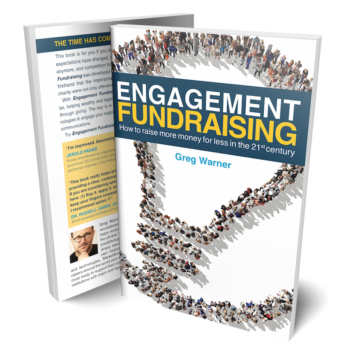We use cookies to ensure that we give you the best experience on our website. By continuing to use this site, you agree to our use of cookies in accordance with our Privacy Policy.
 Login
Login
Your Role
Challenges You Face
results
Learn
Resources
Company
How to be the Obi-Wan Kenobi of Fundraisers to Guide Your Donor’s Hero Journey


The monomyth
The hero is a fundamental human archetype. Jung describes an archetype as, “a spiritual goal toward which the whole nature of man strives.” [1] The monomyth is the hero’s journey. It’s the universal story of fulfilling the hero archetype. Joseph Campbell describes the journey this way: “A hero ventures forth from the world of common day into a region of supernatural wonder: fabulous forces are there encountered and a decisive victory is won: the hero comes back from this mysterious adventure with the power to bestow boons on his fellow man.”[2]
These same elements appear in the personal narratives behind major donations. The donor is the hero. The donor’s life journey connects to the gift. The gift “bestows boons” on those from a donor’s place of beginning.
These story elements are powerful and attractive. As a testament to this, they appear repeatedly in some of Hollywood’s most successful movies. Whether the movie is Star Wars, The Matrix, Harry Potter and the Sorcerer’s Stone, The Hobbit, or many others, the elements are the same.
The fundraiser in the monomyth
Now I know what you might be thinking. You’ve seen all those movies. You don’t remember there being a fundraiser in any of them!
Take a second look. In fact, there is a “fundraiser” character in every one. This “fundraiser” actually plays a key role in the monomyth. This monomyth character is the guiding sage who challenges with a choice. Hannah Ascough describes the start of the monomyth this way: “The story starts with a hero living in an ordinary world. This world is suddenly unbalanced by a disruption or threat and so a mentor approaches the hero and calls her to adventure, providing her with the wisdom and gifts necessary to seek a solution.”[3]
Who is this character in the movies? In the original Star Wars, this is Obi-Wan Kenobi. Consider this conversation from Star Wars:
 OBI-WAN: You must learn the ways of the Force if you’re to come with me to Alderaan.
OBI-WAN: You must learn the ways of the Force if you’re to come with me to Alderaan.
LUKE: Alderaan? I’m not going to Alderaan. I’ve got to get home. It’s late. I’m in for it as it is!
OBI-WAN: I need your help, Luke. She needs your help.
Obi-Wan is delivering the classic fundraiser appeal. “I need your help.” “She needs your help.” This is an appeal to make an impact on the larger world. It’s an appeal to go beyond normal, self-focused, everyday life. It’s an appeal to begin a heroic journey. It’s the call to adventure.
Consider the effective major gift request:
- Is it a call to go forth from the ordinary, small, self-focused world of personal consumption? Yes.
- Is it a challenge to instead make an impact on the larger outside world? Yes.
- Can the gift overcome an enemy or obstacle? Yes.
- Can the donor’s journey create personal reward or transformation for the donor? Yes.
- Can it result in an improvement for the donor’s original world? Yes.
The movie comparisons can be fun. But this isn’t just movie trivia. The Star Wars script was intentionally constructed as an expression of the monomyth. Joseph Campbell helped write it.[4] In an interview, Bill Moyers relates, “[George Lucas] brought Campbell into the process of looking at his work on Star Wars and saying, ‘Is this right? Am I getting it down? Is this the right emphasis? Is this the right character?’ Joseph Campbell said to me, the best student he ever had was George Lucas.”[5]
The monomyth is a worldwide narrative structure. It fulfills the primal human need for heroism. Within this universal human story – satisfying this basic human psychic need – there is a critical role. That critical role is the sage who challenges with a choice. That critical role is the fundraiser. Understanding your role as a fundraiser within this primal narrative context can be helpful. In fact, it can be transformational.
The sage forces a choice
The effective fundraiser must ask. It’s not enough to be friendly and tell good stories. The effective fundraiser must force a choice. The sage plays this same role.
In The Matrix, the sage Morpheus forces a stark choice. He confronts the (prospective) hero.
“This is your last chance. After this there is no turning back. You take the blue pill, the story ends, you wake up in your bed …. You take the red pill; you stay in Wonderland.”
As with young Luke Skywalker, the elements of the choice are the same:
- Stay in your ordinary, self-focused, small world, or
- Go on a journey to impact the larger world.
In The Hobbit, Gandalf challenges Bilbo by saying, “I’m looking for someone to share in an adventure!” The choice is the same:
- Stay in your ordinary, self-focused, small world, or
- Go on a journey to impact the larger world.
Although the traditional guiding sage may be an older man, there are many variations. Researchers explain, “Heroes cannot triumph over these obstacles without help from others. [Joseph] Campbell calls these helpers mentors, who bear a resemblance to the Jungian archetype of the wise old man. These [monomyth] mentors can be friends, teachers, love interests, sidekicks, or father figures.” [6]
They can even be female lions. In The Lion King, Simba is living in his small, self-focused world. This is the “Hakuna Matata” realm of Timon and Pumbaa. Then the lioness Nala challenges him to leave behind that world:
NALA: We really needed you at home.
SIMBA: No one needs me.
NALA: Yes, we do. You’re the king.
The core elements are always present. But they can be shifted around. The original Harry Potter movie provides a twist. The challenge comes by direct mail. The acceptance letter to attend Hogwarts forces Harry to choose:
- Stay in your ordinary, self-focused, small world, or
- Go on a journey to impact the larger world.
In another twist, the challenge comes from two sages. The names of both Professor Minerva McGonagall and Headmaster Albus Dumbledore appear on the letter. Both later serve as guides along the hero’s journey.

The sage gets turned down
So, if you become an epic, Jedi-warrior-level fundraiser, you’ll never have to hear “no” again, right? Wrong.
The hero refusing the call to adventure is not a violation of the story sequence. Quite the opposite: Refusing the call is part of the ancient narrative structure.
What happens when the actual Jedi warrior, Obi-Wan Kenobi, makes his appeal to Luke? Luke turns him down. Only later does he accept the call. How does Neo respond to Morpheus’ first call to escape the ordinary world? Neo turns him down.[7] Only later does he take the red pill. When Nala appeals to Simba to leave behind his self-focused world, what happens? Simba turns her down. Only later does he accept the challenge. How does Bilbo react to Gandalf’s initial challenge? Bilbo turns him down.[8]
The point here is to understand that the refusal is not the end of the story. The refusal is a natural part of the story.[9] The hero refuses. But later, the hero accepts. When the refusal happens, the guiding sage does not disappear. The guiding sage persists.
Any number of factors can change the hero’s mind. Maybe the hero’s ordinary-world circumstances change. (This is Luke.) Maybe the sage returns with more convincing arguments. (This is Gandalf.) Maybe he returns with a final, last-chance request. (This is Morpheus.)
This standard sequence of refusing, then accepting, the call shows the lasting effects of the call to heroism. Even when it is refused, an epic challenge is powerful. It continues to work on the mind of the potential hero. The call to heroism taps into a deep-seated, universal, spiritual goal. But there’s a catch. To have this effect, the challenge must be heroic.
The sage calls to heroism
The call to adventure must provide a challenge to be heroic. There can be no hero story without an epic challenge. When a fundraiser understands her role in this primal story, it should change how she[10] thinks about asking.
Does the sage challenge by apologetically asking small? Of course not. That’s not the role! Failing to understand this ancient role leads to wrong actions. It leads to weak results.
If some fundraisers were playing the role of Gandalf the Grey, the story would be quite different. Why? Because they would shrink from challenging with an epic choice. Instead, they might meekly suggest to Bilbo, “I’m so sorry to inconvenience you. But might you consider a short walk outside the shire? I would really appreciate it. Any time you could spare would help.”
No! No! No! That isn’t the role. That won’t accomplish anything in anyone’s life. The role is to deliver the call to a heroic adventure. The donor hero can make a life-defining impact in the larger world. The donor hero can transform themselves and their world. But the hero needs a guiding sage who makes an epic call to adventure. The donor hero needs an epic fundraiser.
We can have fun with movie comparisons. But the underlying concept is serious. There is primal, hard-wired, operating software in humans that hungers for the hero’s journey. That journey needs a guiding sage who challenges with a heroic choice. Heroism researchers explain, “Transforming mentorship is a pivotal component of the hero’s journey.” [11]
This is the role that the fundraiser can fill in the life story of the donor. This role is to challenge the potential hero to
- Step outside of his ordinary, self-focused, small world of earning and consuming, and
- Go on a journey to impact the larger world.
As a fundraiser, you’re giving people the opportunity to be part of something bigger than themselves. Understanding your role in this primal narrative is key. It should change how you feel. It should change how you feel about apologetically asking small.[12] It should change how you feel about confidently asking big.
Dollars in the door
Fantasy hero stories are fun. Myth and psychology may be fascinating. But let’s get real. How does this connect with actual dollars in the door? Consider this. Joshua Birkholz’s team analyzed nearly 1,000 gift officers to learn what worked and what didn’t. The familiar 80/20 rule appeared. The highest producing 20 percent of fundraisers brought in nearly 75 percent of the total dollars.
What was special about these high performers? One difference was stark. They almost always asked for 100 percent of the donor’s capacity rating. In comparison, “The bottom 80 percent tended to ask for about 40 percent of the capacity ratings.”[13]
The high-performing fundraisers tended to talk in terms of, “How can we get the donor to give at their capacity?”[14]
The lower-performing fundraisers tended to talk in terms of, “How much can we get away with asking them for? What’s the safe request? What is a good number the donor would be comfortable with?”
Mindset matters. One group of fundraisers fulfilled the primal monomyth role. They acted as the sage who challenges with an epic choice. The other group did not.
In a hero story, the sage who challenges with a choice always asks to capacity. No epic story ever began by making a comfortable choice. Heroism isn’t easy. If it were easy, it wouldn’t be heroic. But the fundraiser who challenges with an epic choice is different. She can transform both the donor and the organization.
It’s not just about the ask
Fulfilling this primal role in the donor-hero’s story isn’t simply a matter of adding zeros to an ask. The ask is only a single point in the journey. The relationship with the guiding sage is ongoing. It neither starts nor ends with the challenge.
The guiding sage knows the hero’s origin story. The sage understands the hero’s motivations. The sage introduces the hero to friends and allies who will support the hero in the journey. The sage provides the hero with magical tools to help accomplish the quest. The sage is there before and after the hero accepts the challenge. The guiding sage helps the hero start and finish the hero’s journey.
The guiding-sage fundraiser doesn’t just make a better ask. She makes a better donor experience. She delivers real value. She finishes the story.
Footnotes:
[1] Jung, C. (1953-1978). On the nature of the psyche. In H. Read, M. Fordham, & G. Adler (Eds.), The collected works of C. G. Jung (20 vols). Routledge. Volume VIII, para. 414.
[2] Campbell, J. (1949/2004). The hero with a thousand faces (commemorative ed.). Princeton University Press. p. 28.
[3] Ascough, H. (2018). Once upon a time: Using the hero’s journey in development stories. Canadian Journal of Development Studies/Revue canadienne d’études du développement, 533-549. p. 535.
[4] Larsen, S. & R. (2002). Joseph Campbell: A fire in the mind. Simon & Schuster (Inner Traditions). p. 541.
[5] Becker, E. (Producer), Burns, K., & Becker, E. (Directors). (2004). Empire of dreams. [Motion Picture]. United States: Prometheus Entertainment in association with Lucasfilm. [10:04] et seq.
[6] Allison, S.T., Goethals, G. R, & Kramers, R. M. (2017). Setting the scene: The rise of heroism science. In S. T. Allison, G. R. Goethals, & R. M. Kramer (Eds.), Handbook of heroism and heroic leadership (pp. 1-16). Routledge. p. 3.
[7] When challenged by Morpheus to escape his normal world by climbing outside his office window, Neo’s courage fails and he refuses.
[8] Bilbo responds to the call to adventure by saying, “We are plain quiet folk and have no use for adventures.”
[9] In Harry Potter and The Sorcerer’s Stone, the refusal comes after accepting the initial challenge to attend Hogwarts. Harry says, “I think you must have made a mistake. I don’t think I can be a wizard,” and also, “I can’t be a wizard; I’m just Harry.”
[10] As a convention for clarity and variety, throughout this series the donor/hero is referred to with “he/him/his” and the fundraiser/sage is referred to with “she/her/hers.” Of course, any role can be played by any gender.
[11] Allison, S.T., Goethals, G. R, & Kramers, R. M. (2017). Setting the scene: The rise of heroism science. In S. T. Allison, G. R. Goethals, & R. M. Kramer (Eds.), Handbook of heroism and heroic leadership (pp. 1-16). Routledge. p. 3
[12] Some experimental evidence suggests that making a request apologetically may reduce giving. In an experiment where people experiencing homelessness sold candles from a nonprofit and kept half of the proceeds, the phrase “I’m sorry, would you please buy a Hope candle?” generated significantly lower likelihood of purchase than the phrase “Hope, Hope. Get a scented candle of Hope.” Wei, C., Yu, Z., & Li, Y. (2021). Empathy impairs virtue: the influence of empathy and vulnerability on charitable giving. Internet Research. Study 1B. DOI 10.1108/INTR-07-2020-0407.
Another experiment tracked voluntary contributions for upkeep of a public restroom in Cologne, Germany. The share of people contributing was 66.6% when the sign read “Thank you very much for your contribution!” But this dropped to 56.6% (difference significant at p<.01) when the sign was changed to read, “Thank you very much for your contribution! We apologize for possible inconvenience due to construction works.” Feldhaus, C., Sobotta, T., & Werner, P. (2018). Reminders for voluntary payments might backfire – Evidence from a field study. Economics Letters, 171, 133-136.
Another study used machine learning to identify word clusters in a donation-based crowdfunding website. It found, “While a variety of topic words relating to factual details positively predicted the fundraising outcomes, clusters featuring the overuse of requesting words such as “help”, “money”, and “thank” seemed to backfire on the petitioners.” Xu, L. Z. (2018). Will a digital camera cure your sick puppy? Modality and category effects in donation-based crowdfunding. Telematics and Informatics, 35(7), 1914-1924, 1922
[13] Birkholz, J. M. (2018, January). Planned giving fundraiser metrics. Planned Giving Today, 6-8. p. 7.
[14] Birkholz, J. M. (2018, Sept. 17). Identifying major gift donors. [Presentation]. Practical Planned Giving Conference, Orlando, Florida. The quotation marks here do not necessarily reference direct quotes from the interviewed fundraisers or Birkholz, but rather are my example representations of the general character of the comments.
Related Resources:
- Donor Story: Epic Fundraising eCourse
- The Fundraising Myth & Science Series, by Dr. Russell James
- Why fundraisers must understand the 6 common elements of every donor’s hero story
- The 3 Key Elements of a Good Fundraising Story
LIKE THIS BLOG POST? SHARE IT AND/OR LEAVE YOUR COMMENTS BELOW!
Get smarter with the SmartIdeas blog
Subscribe to our blog today and get actionable fundraising ideas delivered straight to your inbox!
